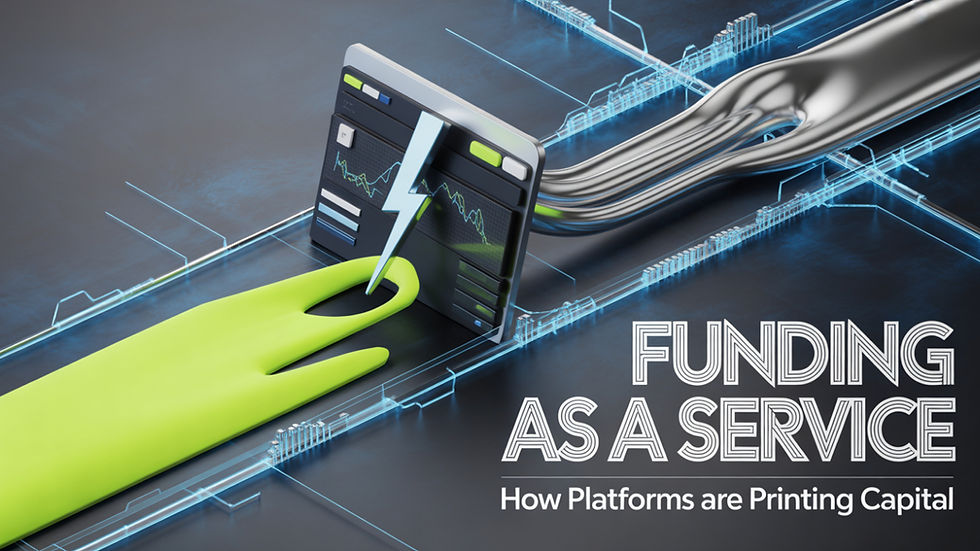Capital-as-a-Service: Why SaaS Platforms Are Becoming the Next Lenders
- Jason Feimster
- Aug 6
- 3 min read
SaaS platforms aren't just selling software anymore—they're offering lifelines.
In a world where speed and agility define survival, platforms like Shopify and Stripe are doing something revolutionary: they're becoming banks. If your platform isn't providing capital, your competitors probably are—and they're locking in your customers for good.
Welcome to the era of Capital-as-a-Service—where offering embedded funding isn't just a value-add, it's a growth strategy.

The Rise of Capital-as-a-Service
Capital-as-a-Service refers to the model where digital platforms offer financing directly to their users, bypassing traditional banks. It's fueled by:
The explosion of embedded finance APIs
The urgency for on-demand capital in digital-first businesses
A growing mistrust of traditional lending processes
Market Leaders:
Shopify Capital: Launched in 2016, offers fast financing based on sales data
Stripe Capital: Introduced in 2019, automates lending decisions in hours
Why SaaS Platforms Are Positioned to Lend
SaaS platforms have three major advantages:
Data Depth – They see real-time behavior, transactions, and customer health.
Trust – Existing user relationships reduce customer acquisition costs.
Retention Power – Lending deepens platform stickiness.
"You're not just a tool anymore—you’re a critical part of your customers' financial backbone."
Case-in-Point: Shopify saw explosive growth by embedding payments and lending. Capital offerings became the secret to merchant loyalty.
Embedded Finance = Exponential Advantage
Embedded Finance means integrating financial tools—like lending—directly into software interfaces. Here's how it plays out:
Shopify Capital: Pre-approved loans, surfaced inside the merchant dashboard.
Stripe Capital: Automated underwriting, repayment through Stripe fees.
Jobber & Housecall Pro: Launched Stripe-powered loans with minimal development.
Impact:
Higher Average Revenue Per User (ARPU)
Reduced churn
Deeper integration into business workflows
From Tool to Financial Ecosystem
Capital offerings move SaaS from a service provider to an indispensable ecosystem:
Example: Shopify Capital + Shopify Payments + Shopify Balance = a closed-loop economy. Merchants never need to leave.
Benefit:
Increased Lifetime Value (LTV)
Harder to churn
Better Net Promoter Scores (NPS)
Alternative Lending Models Powering the Shift
Revenue-Based Financing: Paid back via % of daily sales
On-Demand Capital Lines: Tap into funds instantly
BNPL for B2B: Spread payments over time
AI-Powered Underwriting: Automated, fast, and low-risk
These models create capital liquidity without the red tape.
Roadmap: How to Add Capital-as-a-Service to Your Platform
Decide: Build or Partner?
Build: Total control, complex compliance
Partner: Stripe Capital, Clearco, Pipe
Integrate with APIs
Use Stripe Capital’s platform lending API
Embed pre-approvals in user dashboard
Navigate Compliance
KYC/AML
State-by-state lending laws
Measure ROI
Loan adoption rate
ARPU change
Default & repayment rates
ROI Breakdown: What SaaS Gains by Offering Funding
Shopify: Capital increases merchant retention + expansion
Stripe: Capital users saw up to 114 percentage points more revenue growth
Housecall Pro: Increased user loyalty through capital offers
Capital offerings transform revenue models, retention metrics, and customer satisfaction.
Pitfalls to Avoid in SaaS Lending
Poor underwriting = high default rates
Ignoring compliance can trigger fines
Not educating users on loan terms can hurt trust
Pro Tip: Start with a pilot program and scale with data.
The Future: Financial Services as a Service
By 2030, most SaaS platforms will embed some form of financial service.
Why?
More fintech APIs available
Customer expectations are shifting
Agencies, affiliates, and AI-driven orgs can profit via referral models
Next Step: Explore how fintech platforms like Stripe, Plaid, and Rutter can plug you into this future.
FAQs: Capital-as-a-Service
❓ What is capital-as-a-service?
A model where digital platforms offer financing directly to users through embedded financial technology.
❓ Can SaaS companies offer loans without becoming a bank?
Yes. Use fintech partners like Stripe Capital to embed lending without banking licenses.
❓ How does embedded finance impact revenue?
Increases ARPU, reduces churn, and builds deeper platform loyalty.
❓ Is this only for big platforms?
No. With partner APIs, even niche platforms can embed funding fast.
Final Remarks
The future belongs to platforms that fund their users' growth. Capital-as-a-Service isn’t just an innovation—it’s a competitive moat.
If your SaaS doesn’t offer funding yet, now’s the time to explore embedded lending and rise as a financial ecosystem—not just a tool.
Hot Off the Press!
External Tools & Resources
“Up to 114 percentage points more revenue growth” - Stripe Capital Impact
"Shopify Capital offers fast financing based on sales data” - Shopify Capital Case Study
“Definition of Capital-as-a-Service” - Embedded Finance Overview









Comments